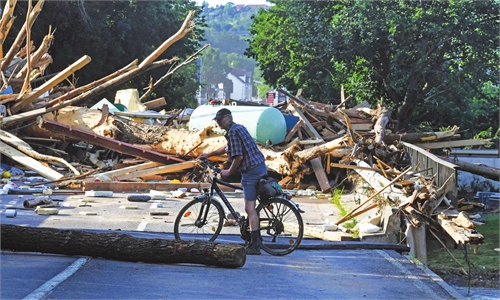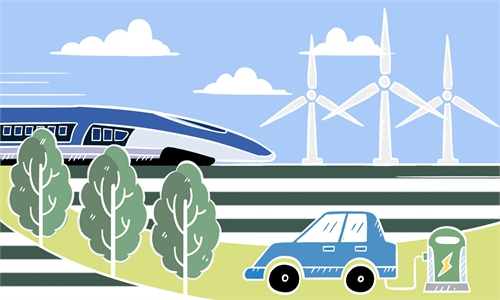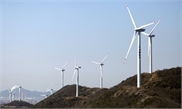
Because of the last rainfalls and the wet environment, it is still very easy to find mushrooms on July 10.Photo: AFP

A man walks around the Gelderland Province, the Netherlands,on July 11. Photo: AFP
What if Earth's atmosphere was infused with extra carbon dioxide, mused amateur scientist Eunice Foote in an 1856 research paper that concluded the gas was very good at absorbing heat.
"An atmosphere of that gas would give to our earth a high temperature," she wrote in the study, published in the American Journal of Science and Arts and then swiftly forgotten.
The American scientist and women's rights activist, who only wrote one more paper, could not have known the full significance of her extraordinary statement, said Alice Bell, author of a recent book on the climate crisis - Our Biggest Experiment - that features Foote.
This was the decade that the US first began to drill for oil. It is also the baseline period of global temperatures we now use to chart the fossil fuel-driven warming of the planet.
Foote, whose work was rediscovered in recent years, is now seen as part of a multi-generational exploration, spanning some 200 years, unravelling the mysteries of how the climate works - and more recently how human activities have tipped it out of balance.
"There is no eureka moment with one great genius in climate change science," Bell told AFP.
"Climate science is a story of people over centuries and different disciplines, different countries working together, incrementally learning more and more."
People have believed human activities like deforestation could alter the local climate since at least the ancient Greeks.
But in terms of the global climate, the story of our understanding of what we now call the greenhouse effect arguably began in the 1820s with French scientist Joseph Fourier.
Greenhouse gases
Fourier calculated that Earth would be much colder if it was not enveloped in an insulating blanket of gases.
"He realized that the atmosphere was doing something to prevent heat immediately being radiated into space," said science historian Roland Jackson.
A few decades later - in perhaps the first documented experiment of CO2's warming potential - Foote filled glass cylinders with ordinary air, moist air and carbon dioxide to see how hot they became in sunlight compared to shade.
The container with CO2 warmed more than the others and "was many times as long in cooling," she reported, although she was not able to make a distinction between Earth's outgoing infrared radiation - which is behind the greenhouse effect - and incoming solar radiation.
"Carbon dioxide can absorb heat, that's her discovery," said Jackson, who co-authored an analysis of her work published by the Royal Society in 2020.
"And she made the supposition from that, that if you increase the amount of CO2, it could change the climate. She needs to be recognized for that."
Cooling fears
A few years later, the Irish physicist John Tyndall performed a more rigorous study showing that water vapor and CO2 absorbed infrared radiation - the mechanism of the greenhouse effect.
His discovery was taken seriously, but even then it was 20 years before his findings on water vapor were fully accepted, said Jackson, who is the author of a biography of Tyndall. "CO2 didn't feature."
In December 1882, a letter to the editor published in Nature cited Tyndall's work on gases. "From this we may conclude that the increasing pollution of the atmosphere will have a marked influence on the climate of the world," said the letter, signed H. A. Phillips, in one of the earliest published links between human-made emissions and a changing climate.
But it would be decades before there was wider concern that coal smoke belching from factories could one day heat the whole planet.
When Swedish scientist Svante Arrhenius - a distant relation of climate campaigner Greta Thunberg - suggested in the late 1800s that burning fossil fuels could influence the climate and calculated what would happen if CO2 doubled, it was not seen as a cause for alarm.
This is not only because the amounts of CO2 being emitted at the time were considered negligible, but also because scientists were preoccupied with understanding the carbon cycle in relation to past ice ages, said Robbie Andrew of the CICERO Center for International Climate Research.
"Nothing survived in large parts of the planet during the Ice Age, that's kind of the thinking - 'We hope we're not going back there,'" he told AFP.
Even into the 1930s, when scientists said temperatures were already rising, they thought a little warming could be beneficial.
"The idea that it changed not only temperatures, but other aspects of climate might not have occurred to them," said Andrew, who has compiled a history of emissions predictions.
'Life itself'
There are a few examples of public commentary linking emissions to the risks of warming, although Andrew said the burning of coal was largely seen as a "necessary evil" and health fears were put aside for the sake of progress.
In 1958, an American television show, The Bell Telephone Science Hour, said CO2 from factories and cars could be warming Earth's climate.
"We are not only dealing with forces of a far greater variety than even the atomic physicist encounters, but with life itself," the narrator said. But fear of global cooling - centered on aerosol pollution and the nuclear winter that would follow atomic warfare - was dominant, and continued well into the 1970s and 1980s.



